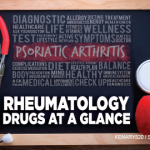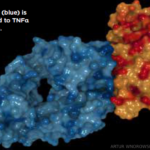Ustekinumab (Stelara):20 injection
Drug class: Monoclonal antibody, interleukin (IL) 12/23) inhibitor
Warnings & Precautions
- Serious infections have occurred. Do not start ustekinumab during any clinically important active infection. If a serious infection or clinically significant infection develops, consider discontinuing ustekinumab until the infection resolves.
- Theoretical infection risk: Serious infections from mycobacteria, salmonella and Bacillus Calmette-Guerin (BCG) vaccinations have occurred in patients genetically deficient in IL-12/IL-23. Diagnostic tests for these infections should be considered as dictated by clinical circumstances.
- Evaluate patients for TB prior to initiating treatment with ustekinumab. Initiate treatment of latent TB before administering ustekinumab.
- Ustekinumab may increase malignancy risk. The safety of using ustekinumab in patients with a history of, or a known, malignancy has not been evaluated.
- Anaphylaxis or other clinically significant hypersensitivity reactions may occur.
- Reversible posterior leukoencephalopathy syndrome (RPLS) has been reported in one case. If suspected, treat promptly and discontinue ustekinumab.
- Cases of noninfectious, interstitial pneumonia, eosinophilic pneumonia and cryptogenic organizing pneumonia have been reported during postmarketing ustekinumab use. If diagnosis is confirmed, discontinue ustekinumab and initiate appropriate treatment.
Dosage & Administration
Subcutaneous Adult Dosage Regimen:
- For patients weighing 100 kg or less, the recommended dose is 45 mg initially and four weeks later, followed by 45 mg every 12 weeks.
- For patients weighing more than 100 kg, the recommended dose is 90 mg initially and four weeks later, followed by 90 mg every 12 weeks.
Subcutaneous Adolescent Dosage Regimen:
Administer the drug subcutaneously at Weeks 0 and 4, then every 12 weeks thereafter.
The recommended dose for adolescents (12–17 years old) is based on body weight.
- Less than 60 kg: the recommended dose is 0.75 mg/kg.
- 60 kg to 100 kg: the recommended dose is 45 mg.
- More than 100 kg: the recommended dose is 90 mg.
Commentary: The FDA approved ustekinumab for moderate to severe plaque psoriasis treatment in adults based on data from two randomized controlled studies, and in adolescents based on data from one randomized controlled study. The PASI 75 results were both clinically and statistically significant at the end of the study. The most common adverse reactions (≥3%) are arthralgias and nausea.
Brodalumab (Siliq):21 injection
Drug class: Monoclonal antibody, IL-17 receptor antagonist (IL-17-RA)
Boxed warning: Suicidal ideation and behavior
- Suicidal ideation and behavior, including completed suicides, have occurred in patients treated with brodalumab.
- Prior to prescribing, weigh potential risks and benefits in patients with a history of depression and/or suicidal ideation or behavior.
- Patients with new or worsening suicidal thoughts and behavior should be referred to a mental health professional.
- Advise patients and caregivers to seek medical attention for manifestations of suicidal ideation or behavior, new onset or worsening depression, anxiety, or other mood changes.
- Brodalumab is available only through a restricted program called the SILIQ Risk Evaluation and Mitigation Strategy (REMS) Program.
Warnings & Precautions



